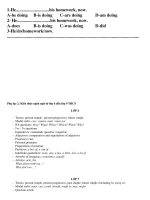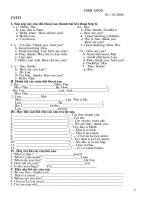tieng anh tham khao 10cb
Bạn đang xem bản rút gọn của tài liệu. Xem và tải ngay bản đầy đủ của tài liệu tại đây (227.65 KB, 3 trang )
Preparing date: 15 / 03/ 2009
Teaching Date: 21/ 03 / 2009
Period: 77
UNIT 13:
Lesson 1: READING
I. Objectives:
1. Education aims: - To help students know more about the history of films.
- To develop students’ reading skills
2. Knowledge:
a. General knowledge: - Knowledge about films and cinema.
b. Language: - The past simple tense.
- Vocabulary concerning music: scene, camera, character......
3. Skills: - Speaking: talk in pairs and in groups.
- Reading comprehension: better sts' reading skill through finding the word meanings in contexts,
answering questions and identifying the main idea.
II. Anticipated problems:- Students may not have much knowledge and words/phrases about films and cinema.
III. Teaching aids: textbook, laptop, screen, handouts….
IV. Procedures:
1. Organization (1min): Check ss’ attention.
2. Check – up (5mins):
3. New lesson:
TEACHER’S AND STUDENTS’ ACTIVITIES CONTENT
I. BEFORE YOU READ:( 12 mins)
1. Warm-up:(5 mins)
-T: Show pieces of video and ask ss to watch and
classify them by kinds of films.
- SS: Watch the pieces of video carefully then
classify them.
- T: Call on some ss to give answers.
- SS: Stand up and give answers.
-T: Get feedback and check.
-T: Ask ss to rearrange the kinds of films in order
of time.
-Ss: Do as required.
-T: Feedback and lead ss into the new lesson.
2.Vocabulary.
-T: Play the tape once before teaching new words.
-Ss: Listen
-T: Provide sts with the new words/phrases:
-SS: Write down these words into their notebooks.
-T: Read each word/phrase twice and ask sts to
A. READING
I. BEFORE YOU READ
Vocabulary:
- Sequence (n)['si:kwəns] : chuỗi (sự kiện, hành động)
- To set st in motion (v phr): tạo chuyển động
ex: They set a sequence of pictures in motion to make a cartoon film.
- Decade (n) ['dekeid] : a period of 10 years.
repeat.
- SS: Listen and read after the T.
-T: Ask some sts to read all the word/phrases
aloud in front of the class -SS: Listen and repeat.
-T: Listen and help sts to read the words/phrases
correctly.
3. Vocabulary checking (Task 1):
-T: give some English explanations and ask ss to
give English words.
-Ss: Do as required.
-T: Feedback.
II. WHILE YOU READ:( 18 min)
1. Task 2: Answering questions:
-T: Ask sts to work in pairs to read the passage
more carefully and find the answers to the
questions given.
-SS: find the answers to the questions given
-T: Ask sts to highlight the information in the
passage that helps them to find the correct
answers.
-SS: underline the information in the passage
- T: ask ss to give answers in front of the class.
- T: Listen and help the students to give correct
answers.
2. Task 3: Choosing the best title:
- T: Ask sts to read the passage again individually
and choose the best title for the passage.
-SS: Do as required.
- T: Ask one or two sts to give answer & explain
why they choose A, B or C.
- SS: report.
-T: Listen and check.
III. AFTER YOU READ:( 9 mins)
-T: Ask sts to look at the table then scan the
passage to find out the answers.
-SS: Work in groups and do as required.
-T: Check sts’ answers and give correct ones.
-Ss: Take note.
- Rapid (adj) ['ræpid] : quick, fast
→ Rapidly (adv)
- Character (n) ['kærəktə] : nhân vật
- It was not until……that….: mãi cho đến lúc…..
ex: It was not until 1915 that cinema really became an
industry.
2. Vocabulary checking:
Fill each gap with a suitable word whose explanation is in
the right.
II. WHILE YOU READ
1. Task 2: Answering questions.
Answers:
1. In the early 19
th
century.(line 1)
2. They discovered that when a sequence of still pictures
were set in motion, they could give the feeling of
movement.(lines 2,3)
3. No, they didn’t. (line 15)
4. In the early 1910s ( line 9)
5. At the end of the 1920s (line 14)
Task 3: CHOOSING THE BEST TITLE
Answer:
B ( A brief history only)
III. AFTER YOU READ:
5. Consolidation: Summarize the main points of the lesson.
6. Homework:( 1 min)- Ask ss to finish all tasks into their notebook & prepare for the next lesson.
Self evaluation:
SUPPLEMENT
==================== ====================









